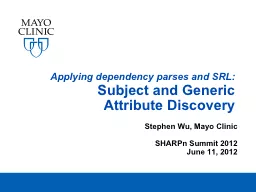

Subject and Generic Attribute Discovery Stephen Wu Mayo Clinic SHARPn Summit 2012 June 11 2012 Outline Motivation and Role Generic Attribute Definition Methods amp Examples Subject Attribute ID: 543619
Download Presentation The PPT/PDF document "Applying dependency parses and SRL:" is the property of its rightful owner. Permission is granted to download and print the materials on this web site for personal, non-commercial use only, and to display it on your personal computer provided you do not modify the materials and that you retain all copyright notices contained in the materials. By downloading content from our website, you accept the terms of this agreement.
Slide1
Applying dependency parses and SRL: Subject and Generic Attribute Discovery
Stephen Wu, Mayo Clinic
SHARPn Summit 2012
June 11, 2012Slide2
OutlineMotivation and RoleGeneric AttributeDefinitionMethods & ExamplesSubject Attribute
Definition
Methods & Examples
Status & Future WorkSlide3
Attribute DiscoveryClinical Element ModelsExclude genericFamily history
Methods: Dependency Parser and SRLSlide4
Methods summaryTypes of rulesNoun phrase structurePath to rootPath between pairsSemantic arguments
Feature vector
Decision logic/MLSlide5
(a) The patient was referred to the
Lupus
clinic.
(b) We discussed increased risk of
breast cancer
Definition
:
“refers to mentions, which are generic, i.e., not related to the instance of a disorder, sign/symptom, etc…”
“… Mentioned as part of a general statement with no clear subject/experiencer.”
Values
:
in {true, false} default=false
Generic: Attribute DefinitionSlide6
Ex: Noun phrase structure Rule (a) The patient was referred to the Lupus clinic.
Find the headword of the NE
Modifies another noun (nmod)?
Generic: Dependency parse rules
referred
patient
w
as
sbj
adv
nmod
to
the
pmod
vc
nmod
clinic
the
nmod
L
upus
generic=
trueSlide7
Ex: Path to root Rule (“Discussion” context) (b) We discussed increased risk of breast cancer
Find NE headword
Path to top
“Discussion” word?
Generic: Dependency parse rules
increased
discussed
sbj
nmod
nmod
risk
We
pmod
obj
of
breast
nmod
cancer
discuss,
ask, understand, understood, tell, told, mention, talk, speak, spoke, address
generic=
trueSlide8
(c) The patient’s son has
schizophrenia
.
(d) Father died of
MI
in 50’s
Definition
:
“
The person the observation is on. This modifier refers to the entity experiencing the disorder.”
Values
:
in {Patient, Family_Member, default=Patient Donor_Family_Member,
Donor_Other, and Other}
Subject: Attribute DefinitionSlide9
Ex: Semantic argument Rule (c) The patient’s son has schizophrenia.
Semantic argument
(ARG0, ARG1)
Family term (WordNet)
Subject: Semantic role labeling rules
‘s
patient
has
PRED
the
schizophrenia
ARG1
subject=
family_member
son
ARG0
father, dad, mother, mom, bro, sis, sib, cousin, aunt, uncle, grandm, grandp, grandf, wife, spouse, husband, child, offspring, progeny, son, daughter, nephew, niece, kin, familySlide10
Ex: Path to root Rule (family) (d) … father who died of MI in 50's
Find NE headword
Path to top
Family term?
Subject: Dependency parse rules
MI
father
pmod
died
pmod
adv
in
50s
tmp
subject=family_member
of
who
nmod
nmodSlide11
Ex: Dependency paths Rule (d) Father died of MI in 50's
NE + “Family” pairs
Find dependency path
Once-removed?
Subject: Dependency parse rules
MI
Father
pmod
died
pmod
adv
in
50s
tmp
subject=family_member
of
s
bjSlide12
Methods summaryTypes of rulesNoun phrase structurePath to rootPath between pairsSemantic arguments
Feature vector
Decision logic/MLSlide13
Status and Future WorkcTAKES v2.5“Assertion” moduleDefaultFuture work (with data)
Evaulation & Error analysis
Improved rules
Features in machine learningSlide14
Thank you.https://sites.google.com/site/stephentzeinnwuwu.stephen@mayo.edu
Task 4/6 team:
Stephen Wu
Cheryl Clark
James Masanz
Matt Coarr
Ben Wellner
Special thanks to:
Lee Becker
Guergana Savova
Pei Chen
This work was supported in part by the SHARPn (Strategic Health IT Advanced Research Projects) Area 4: Secondary Use of EHR Data Cooperative Agreement from the HHS Office of the National Coordinator, Washington, DC. DHHS 90TR000201.